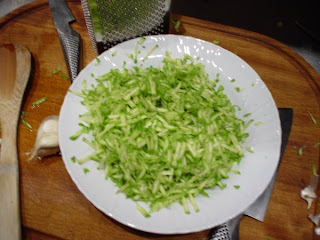It's been a strange tomato growing season.
Well, so was last year. Last year's summer was achingly hot and bone dry. My tomato crop was miles below par - not much fruit and a lot of it stunted. I wasn't alone. Adriana, who runs a commercial market garden just outside the town walls, had exactly the same problem. She didn't have enough tomatoes - or any other vegies, for that matter - to supply her regular customers.
This year, spring was the coolest and wettest in either 20 or 200 years. Depending to whom you speak. Suddenly, though, in mid-June, the daytime temperatures shot from an average 18C to around 30C. We somehow missed the 20s altogether.
The result? The plants that had started to set fruit were all right. Those that hadn't, struggled in the sudden, intense heat. End result? They weren't setting fruit:

The luckier ones did:

The yellows on the top RHS are Jaune Negib, a French heirloom. They're a very early variety - usually around 60 days from planting out - and their major flavour attribute is a lovely creamy aftertaste. Most very early varieties - Stupice and the like - are usually flavour-deficient because, developing and ripening quickly, as their genes insist they do, they simply don't have the time to develop real flavour or complexity. They're really only worth growing if you have a very short growing season and later varieties aren't viable. Jaune Negib, though, is rare amongst very early varieties because they do have something to offer in the flavour department. Even if I only grow them for
L'artista to turn into yellow tomato chutney.
The gold/orange pair - one its usual golf-ball size, the other a freak midget - at the bottom are Jaune Flammée, yet another French heirloom. A lovely, much overlooked tomato with a fresh, very tangy flavour. The surprise is that they matured as early as they did. Normally they take longer than Jaune Negib.
The two red cherry tomatoes are actually conjoined Camp Joy (aka Chadwick's Cherry):

Siamese tomatoes. Take two tomato blossoms extremely close together, have them both fruit at the same time, and the resultant tomatoes can fuse together. Grow enough tomatoes and you'll see plenty of conjoined ones. These two are smaller than the usual Camp Joy, hence they ripened earlier than Camp Joy usually does. They normally takes up to 75 days. Here's one ripening on the vine:

I've grown most of the well-known cherry varieties over the years and I keep coming back to Camp Joy (aka Chadwick's Cherry) for their genuine flavour, reliability and huge crops.
Now I have my fingers crossed for the stragglers to start setting fruit.
 Grate the zucchini using the biggest holes on the grater:
Grate the zucchini using the biggest holes on the grater: Drop a good knob of butter and some peeled, chopped garlic into a large pan:
Drop a good knob of butter and some peeled, chopped garlic into a large pan: When the butter has melted and taken the flavour of the garlic, toss in the grated zucchini and stir it around. The key is not to cook down the zucchini to a pulp. It should have texture to it. The process should take no longer than five or six minutes:
When the butter has melted and taken the flavour of the garlic, toss in the grated zucchini and stir it around. The key is not to cook down the zucchini to a pulp. It should have texture to it. The process should take no longer than five or six minutes: Season the zucchini to taste, then drain your cooked pasta - you can use spaghetti, linguine, bucatini, any of the thinner pastas - and add it to the zucchini in the pan:
Season the zucchini to taste, then drain your cooked pasta - you can use spaghetti, linguine, bucatini, any of the thinner pastas - and add it to the zucchini in the pan: Stir thoroughly to mix very well.
Stir thoroughly to mix very well. I've tried it with and without parmesan. I think parmesan renders the dish gluggy.
I've tried it with and without parmesan. I think parmesan renders the dish gluggy.












